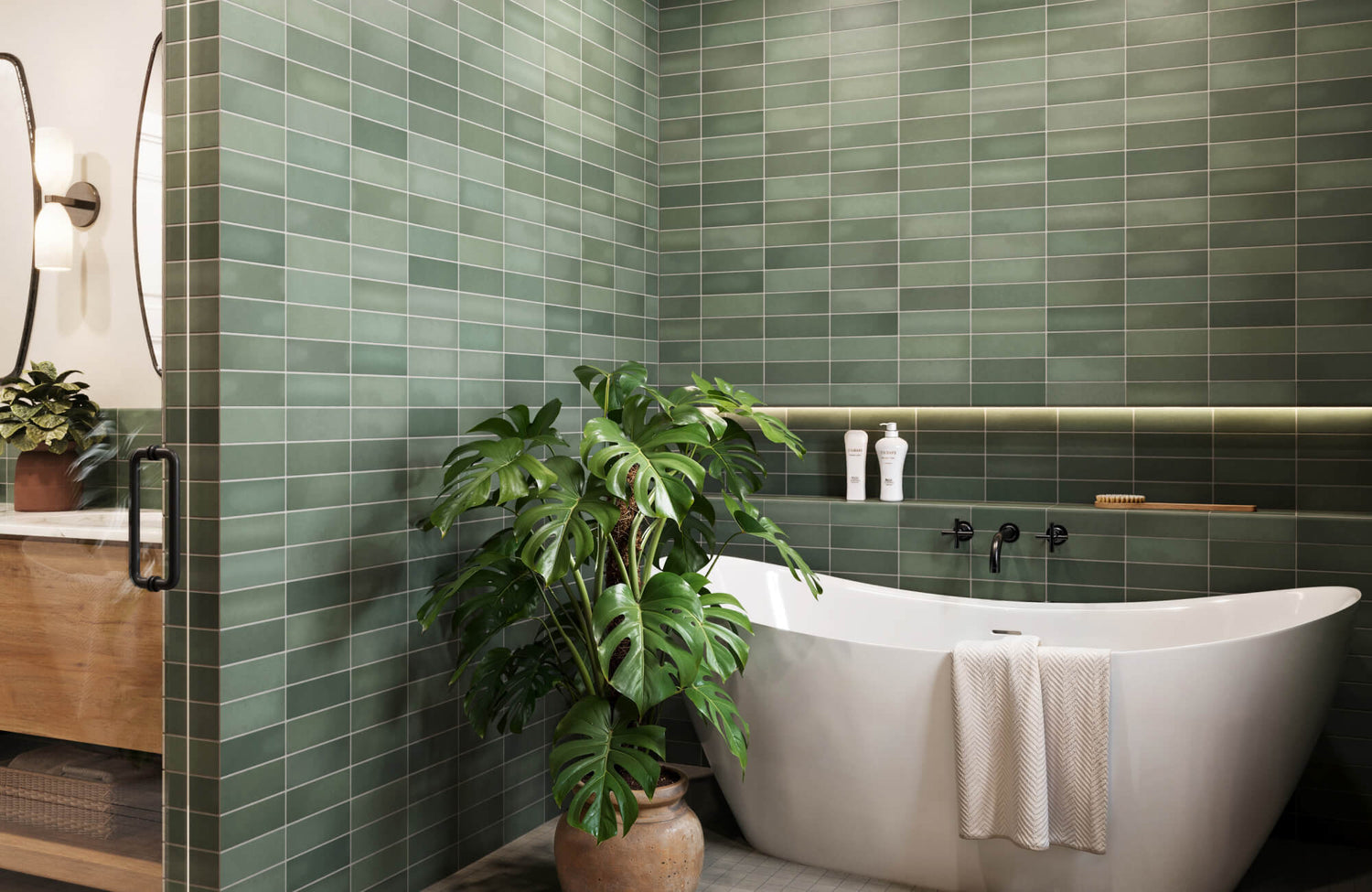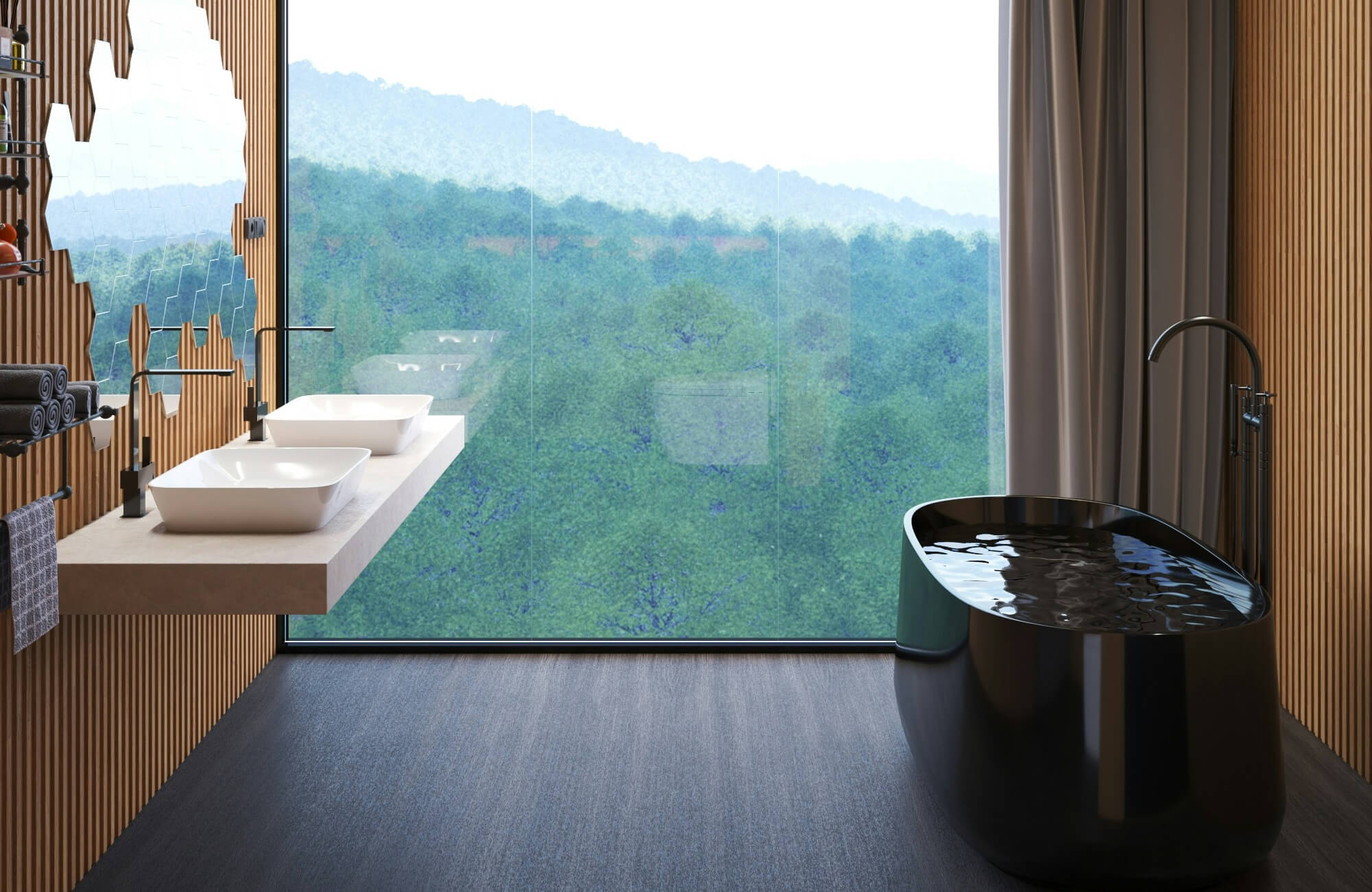Originating in the early 20th century, subway tile has grown from a practical solution for New York City subway stations into a design icon. Over the decades, it has evolved into a versatile choice for interiors, seamlessly blending classic charm with contemporary aesthetics. Modern subway tile offers diverse colors, finishes, and sizes, making it adaptable to both minimalist and eclectic styles while retaining its timeless appeal.
In this article, we’ll explore the reasons behind its enduring popularity, dive into contemporary interpretations, and highlight its sustainable benefits. Finally, we’ll share tips on how to use modern subway tiles effectively to elevate different interior spaces.
Why Subway Tile Is a Timeless Classic
Subway tile has earned its status as a design staple by its ability to adapt to various styles and spaces, making it equally effective as a clean, understated backdrop or a bold focal point. This balance of simplicity and adaptability allows subway tile to remain relevant across shifting design trends while staying true to its practical and elegant origins.
At the core of its appeal is its minimalist design. Their simple rectangular shape and smooth surface bring a sense of order and refinement, making subway tiles a versatile choice for both residential and commercial interiors. For instance, classic white subway tiles offer a crisp, timeless look, while matte finishes create a softer, more subdued aesthetic. For those seeking a contemporary edge, vibrant hues and bold patterns provide opportunities for creative expression.
Subway tile’s durability further enhances its appeal. Glazed ceramic and porcelain options resist moisture, heat, and scratches, making them ideal for high-use areas like kitchens and bathrooms. Their non-porous surfaces also prevent water absorption, ensuring longevity and easy maintenance. Whether paired with natural wood for warmth, brushed metal for a modern industrial vibe, or bold textiles for contrast, subway tile’s adaptability and resilience solidify its place as a cornerstone of interior design.

Modern Interpretations
Subway tile has evolved beyond its utilitarian beginnings to become a platform for modern design innovation. Its modular shape and versatile nature make it an ideal choice for experimenting with bold aesthetics, creative layouts, and functional improvements. These qualities enable it to remain a contemporary staple while pushing the boundaries of traditional design.
Redefining Subway Tile Colors
Modern subway tiles have embraced color innovation, introducing vibrant hues and shade variations that go beyond traditional neutrals. These advancements leverage the classic rectangular shape, transforming it into a dynamic canvas for contemporary design. Edward Martin’s Everly 3x8 Matte Ceramic Tile in Forest, as displayed in the photo above, highlights this evolution with its green tone and high shade variation that conveys a bespoke, hand-finished look. This artisanal quality sets it apart from traditional subway tiles, adding depth and character that enhances the uniqueness of any space.
Subway tiles now embrace nature-inspired colors as well, drawing from the soft greys of marble, the warm browns of stone, or even the muted greens of aged patina. These earthy tones bring a grounded, organic feel to interiors while offering versatility for modern and classic designs alike. In addition, the modularity of subway tiles supports creative techniques, such as blending gradients, alternating shades, or using contrasting grout for added interest. Whether as a focal point in minimalist designs or part of intricate layouts, these modern options show how thoughtful color and texture transform interiors with style and versatility.
Innovative Textures
Subway tiles have also embraced modern textural innovations, adding depth and interest to their classic form. Beyond traditional matte and glossy finishes, new textures such as 3D surfaces, grooved patterns, satin finishes, and crackled effects bring fresh design possibilities to both walls and backsplashes.
3D subway tiles introduce raised geometric patterns that create a sculptural, dynamic look. These designs interact with light and shadow, making them ideal for feature walls or bold focal points. Grooved subway tiles, on the other hand, offer a subtler texture, adding understated depth while maintaining clean lines, making them a great fit for minimalist interiors.
Specialty finishes further expand the range of subway tile applications. Satin subway tiles, with their soft, understated sheen, strike a balance between the high reflectivity of glossy finishes and the muted elegance of matte. Crackled finishes, with their fine, web-like surface fractures, evoke a vintage, handcrafted feel, blending seamlessly into both traditional and modern spaces.
Elongated and Large Formats
The evolution of subway tiles in size has opened new possibilities for interior design, combining timeless appeal with contemporary versatility. While the traditional 3x6 format continues to define the classic subway tile look, modern elongated versions, such as 4x16 and 6x24 subway tiles, bring a sleek, updated aesthetic to both kitchens and bathrooms. These larger formats reflect modern preferences for clean, uninterrupted surfaces and minimal grout lines.
Elongated subway tiles reduce the visual clutter of grout, creating smoother, more cohesive designs. Their extended proportions also lend themselves to creative layouts, such as vertical stacking for added height or herringbone patterns for dynamic movement. These variations allow for more personalized and visually striking spaces while retaining the structured simplicity that subway tiles are known for.
In kitchens, for example, horizontally placed 6x24 subway tiles can create a seamless backsplash that pairs beautifully with contemporary cabinetry and fixtures. In bathrooms, 4x16 subway tiles can be arranged vertically to enhance the perception of height, making smaller spaces feel more open. These large, elongated formats also work well in transitional spaces, blending classic proportions with a modern edge.
Sustainable Materials
Modern subway tiles go beyond aesthetics by integrating sustainability into their design, making them an eco-conscious choice for today’s interiors. Their production increasingly incorporates recycled materials and eco-friendly processes, aligning with the growing demand for environmentally responsible design.
Recycled content and low-emission glazes are common innovations in subway tile manufacturing. These practices reduce waste and improve indoor air quality, ensuring that the tiles contribute positively to both environmental and personal health. Combined with their durability, which minimizes the need for frequent replacements, subway tiles offer long-lasting value while reducing resource consumption.
Subway tiles also enhance energy efficiency in subtle but impactful ways. Their thermal stability helps maintain comfortable indoor temperatures by retaining heat during winter and staying cool in summer, reducing reliance on heating and cooling systems. Glossy finishes further contribute by reflecting natural light, brightening interiors, and lowering the need for artificial lighting.
Subway Tiles as Accents
Subway tile offers more than timeless appeal—it can also bring a modern twist to interiors through creative accent applications. By incorporating unique designs, materials, and layouts, subway tiles can transform ordinary spaces into personalized statements of style.
Framing and Highlighting Features
Modern subway tiles have evolved beyond their traditional uses, now serving as a tool to frame and emphasize architectural elements. This approach transforms functional areas into focal points, creating visually distinct and stylish accents in both contemporary and classic interiors.
Elongated subway tiles, such as the Jaden 2.5x16 Glossy Ceramic Tile in Dove, exemplify this innovation. Their slim, modern profile and reflective surface enhance features like backsplashes, shower niches, or vanity mirrors, drawing attention while maintaining a sleek aesthetic. Using bold grout colors or pairing them with metallic fixtures can further amplify their framing effect, adding depth and contrast to your design.
Another modern technique involves incorporating textured or metallic subway tiles for framing, which enhances the impact of elements like windows, shelving, or alcoves. Lighting plays a key role here—integrating LED strips or positioning fixtures around tiled frames not only highlights the feature but also creates a layered, dynamic look. These subtle additions elevate the design while blending seamlessly with the surrounding space.
Creating Artistic Inlays
A tile inlay is a decorative design or pattern embedded into a tiled surface, used to add a focal point or enhance the visual appeal of a space. By combining different shapes, colors, or materials, inlays can elevate an otherwise simple surface into a unique, personalized feature. They are commonly used on floors, walls, backsplashes, or accent areas to bring character and style to a design.
With subway tiles, artistic inlays open up a world of creative possibilities. Geometric patterns, such as chevrons or hexagons, introduce movement and dynamic visual interest, while gradient or ombre effects using varied shades create depth and subtle transitions. For a modern edge, asymmetrical layouts like offsetting tiles or mixing sizes add an unconventional flair without overpowering the overall design.
To further enhance texture and contrast, incorporating materials like glass or metallic accents can provide a reflective or shimmering quality. A mix of matte and glossy finishes also plays with light to create a layered, multidimensional effect. Custom inserts, such as circular or hexagonal tiles, work particularly well as focal points, making the inlay not just decorative but a distinctive design statement.
Decorative Accents in Unexpected Places
Subway tiles can bring unexpected charm to unconventional areas, showcasing their adaptability in modern design. For instance, using these tiles to line the edges of open shelving creates a subtle but visually appealing accent. Similarly, stair risers can be enhanced with bold patterns or textured variants, transforming a functional element into a standout feature.
In kitchens, subway tiles can also be used to clad the base of a kitchen island, introducing a cohesive and stylish look that ties the space together. In bathrooms, they work well to frame mirror edges or serve as decorative strips within plain walls, adding subtle texture and detail. Smaller areas, such as the backs of bookshelves or window sills, can also benefit from subway tiles in unique finishes, like 3D embossed styles, for a polished yet understated effect.

Modern Design Tips
Modern subway tile design thrives on creative layouts and purposeful details. Edward Martin’s Olivia 4x16 Glossy Ceramic Tile in Cotto (photo above) offers a perfect example, combining a warm, peachy tone with a large format that feels fresh and expansive. Its herringbone arrangement adds dynamic movement, balancing modern style with subtle texture.
In kitchens, you can use these Olivia tiles as a full backsplash to create a sleek, uninterrupted surface with their larger size that minimizes grout lines. You can also pair them with black fixtures, natural wood cabinets, and under-cabinet lighting to emphasize their glossy finish and add warmth to the space.
For bathrooms, vertical layouts elongate walls, creating a modern, airy aesthetic. These same subway tiles can be paired with floating vanities and frameless mirrors to enhance this effect, resulting in a streamlined, spa-like environment. Alternatively, mixing them with contrasting elements like brushed metal or matte finishes adds depth and a refined industrial touch.
To visualize how different tile sizes, colors, and layouts will look in your home, Edward Martin’s augmented reality (AR) tool is an invaluable resource. This innovative feature allows you to virtually place various subway tile options in your space, helping you make confident design decisions and ensuring your final choice complements the overall decor seamlessly.
The Appeal of Subway Tile in Modern Homes
Subway tile has evolved from its functional origins into a timeless design staple, valued for its durability, adaptability, and aesthetic appeal. Available in a variety of colors, textures, and layouts, it suits both classic and modern interiors, offering endless possibilities for creating stylish and environmentally responsible spaces.
To bring these possibilities to life, Edward Martin’s design services offer tailored guidance for achieving your ideal subway tile look. Their expertise in selecting the perfect color, texture, and layout ensures seamless integration into your space, helping you create a cohesive and stunning design.










